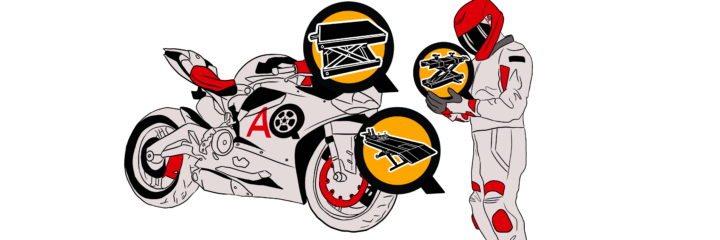For motorcyclists, a garage lift is a badge of honor. It shows capability, mechanical knowledge, and a commitment to taking care of your bike.
A motorcycle lift can even turn your garage into a social spot for you and your riding buddies—we all know that one guy who’s got the best setup for wrenching on bikes, the buddy who has a full set of tools, a couple of lifts, and a little more mechanical knowledge than everyone else. A nice lift is the first step to creating the garage of your dream, the garage that becomes the local hangout for your riding friends.
- Features to Consider in a Motorcycle Lift
- Top 10 Best Motorcycle Lifts 2026
- 1. Best Overall Motorcycle Lift: ZENY 1100 Motorcycle Center Lift
- 2. Best Premium Motorcycle Lift: PlusLift MT1500X 1500 Pound Air Lift
- 3. Best High-Capacity Motorcycle Lift: OTC 1545 Motorcycle Lift
- 4. Most Durable Motorcycle Lift: Big Red Torin Hydraulic Powersports Lift Jack
- 5. Best Budget Motorcycle Lift: Liftmaster Wide Deck Motorcycle Lift
- 6. Best Motocycle Scissors Jack: Extreme Max Scissors Jack
- 7. Easiest Motorcycle Lift to Use: BikeMaster Easy Lift and Lower Off-Road Motorcycle Jack Stand
- 8. Best Portable Motorcycle Lift: Orion Motor Tech Scissor Jack
- 9. Best Motorcycle Lift Table: Extreme Max Hydraulic Motorcycle Lift Table
- 10. Best Foot-Operated Motorcycle Lift: Pit Posse Motorcycle Hydraulic Scissor Table Stand
- Guide to Buying the Best Motorcycle Lifts for 2026
- Frequently Asked Motorcycle Lift Questions
- Wrapping Up
Features to Consider in a Motorcycle Lift
Motorcycle lifts range from tiny $70 lifts that lower and raise via a simple hand screw to massive, thousand dollar lifts with large platforms and extensive, automatic hydraulic jack systems. When evaluating where a lift sits on the spectrum, think about the following features to see how one lift compares to others.
Form Factor
Motorcycle lifts range in size and complexity. Some motorcycle lifts are simple and elevate a motorcycle with a small hand jack, others are massive with full platforms requiring a large amount of floor space. Some lifts, especially professional models can even be built into the floor for maximum ease of use. Although lifts can sometimes have overlaps in their form factor, for our purposes, we’ll divide them into a few categories:
Motorcycle/ATV Lifts
Lifts that are compatible with both motorcycles and ATVs are some of the biggest and most expensive types of motorcycle lifts. They have a large footprint in a garage and they’re rated to the highest weight limits of any type of motorcycle lifts—typically around 1,500 pounds, heavier than the heaviest motorcycles.
Scissor Jacks
Typically rated to a slightly smaller weight limit of around 1,000 pounds, a scissor jack is small enough to tuck away in a corner. These types of lifts are a little less stable than other lifts due to their shoebox-size footprint. They elevate without using hydraulics, instead using a simple screw to raise and lower your bike.
Lift Tables
Lift tables have a similar footprint to scissors jacks, but use hydraulics instead of screws to lift motorcycles. They’re great for getting a motorcycle high into the air, but they also have the lowest weight limit of most motorcycle jacks.
Jack Stands
Motorcycle jack stands are typically the simplest type of lift, using the basic principle of leverage to lift up a motorcycle. They’re inexpensive but require more physical input, and can also be less stable.
Ramp Lifts
Ramp lifts can be rated for heavy ATV weights but they’re typically designed for motorcycles. It’s quite easy to load a motorcycle on a ramp lift, as you can just roll it directly on the table and then jack it up immediately. Ramp lifts are more expensive and can have more complex elevation mechanisms; some of them use electricity instead of a hand crank to physically lift the motorcycle. These are the same types of lifts used by professionals.
Lifting Mechanism
The purpose of a lift is to get a motorcycle off the ground, so every motorcycle lift has a jack, winch, or motor that allows it to hoist motorcycles. Most of the time, lifting happens using the same hydraulic technology you might be used to in a car jack. Sometimes the lift mechanism used could be an air jack, with compressed air lifting the motorcycle. Other times different types of non-pressurized technologies like screws or motors are used, sometimes in combination with some type of hydraulic.
Hydraulic
There are several formats of hydraulic jacks, from bottle jacks that come stock on most cars to huge electric/hydraulic combination jacks for professional ramp lifts. The principle is the same: pressurize some type of hydraulic fluid via a pump that pushes the lifting surface up, slowly and securely lifting the motorcycle.
Hand Crank
Typically seen on scissor jacks, a hand crank doesn’t rely on hydraulics, just a single screw that when rotated pulls the two sides of the scissor jack together, lifting up the motorcycle. These are simple, cheaper, and don’t ever leak hydraulic fluid, but on poorly-built variations, high weight loads on the parts can lead to dramatic failure when bolts strip or bend.
Air Lifts
Air lifts, also known as air jacks, aren’t particularly common for use by amateurs, but they are prized for their speed when lifting a motorcycle and for this reason, they’re most commonly seen at the race track. Air, although not as stable as hydraulic fluid, can be highly pressurized and lift a motorcycle in a matter of milliseconds. If you’re not using this type of jack for racing, you’ll be better served by a hydraulic jack or hand crank jack.
Alternatives
There are other ways to elevate motorcycles, from winches to levers to simple elevated platforms. These aren’t really ‘motorcycle lifts’ as the community thinks about them, so while you might be able to lift a motorcycle this way, these devices aren’t typically known as motorcycle jacks. This article will only cover jacks and lifts as they’re conventionally recognized.
Weight Capacity
Motorcycles can have huge weight variations. A Harley Davidson Road Glide weighs almost 1,000 pounds loaded with gas while a small bike like a Honda Monkey barely weighs 200. Shop for a lift with your bike’s weight range. If you’re working mostly on small dirt bikes, a 300-pound weight limit is fine. If you want something that works for your ATVs and trikes, you’ll need something a bit more heavy-duty.
At the end of the day, you can’t really go wrong with a high weight-limit for your jack. It’ll be a little more expensive and might have a larger footprint in your garage, but it’s safer for you and your bike, all while giving you some room to upgrade to a bigger motorcycle down the road.
Ease of Use
Since most motorcycle work is hypothetically possible to perform without elevating the bike, one of the most important aspects of a motorcycle lift is how easy it is to use. There are a couple of aspects to this: the height of the lift, because the higher the bike is elevated, the easier the work becomes. Jacks can vary in usability, and jacks with comfortable handles and levers are better than hand jacks with small hardware that pinches hands and leaks hydraulic fluid.
To help you get there, we’ve created a list of the best motorcycle lifts available today. They range from premium auto-shop quality rigs to smaller, inexpensive units that are better for hobbyist setups. Either way, with a bit of elbow grease and willpower, a motorcycle lift is the best way to take your wrenching to the next level.
| Product | Form Factor | Lifting Mechanism | Weight Capacity | Rating |
|---|---|---|---|---|
| ZENY 1100 Motorcycle Center Lift | Scissor Lift | Hand Crank | 1,100 pounds | 5 |
| PlusLift MT1500X 1500 Pound Air Lift | Ramp Lift | Hydraulic/Air Lift Combination | 1,500 pounds | 4.5 |
| OTC 1545 Motorcycle Lift | Motorcycle/ATV Lift | Hydraulic | 1,500 pounds | 4.5 |
| Big Red Torin Hydraulic Powersports Lift Jack | Motorcycle/ATV lift | Hydraulic | 1,500 pounds | 4.5 |
| Liftmaster Wide Deck Motorcycle Lift | Scissor Lift | Hand Crank | 1,100 pounds | 4.5 |
| Extreme Max Scissors Jack | Scissors Jack | Hand Crank | 1,000 pounds | 4 |
| BikeMaster Easy Lift and Lower Off-Road Motorcycle Jack Stand | Jack Stand | Damper shock with lever | 350 pounds | 4 |
| Orion Motor Tech Scissor Jack | Small-Footprint Scissor Jack | Hand Crank | 1,000 pounds | 4 |
| Extreme Max Hydraulic Motorcycle Lift Table | Lift Table | Hydraulic | 300 pounds | 4 |
| Pit Posse Motorcycle Hydraulic Scissor Table Stand | Hydraulic Scissors Jack | Hydraulic | 300 lbs | 3.5 |
Top 10 Best Motorcycle Lifts 2026
1. Best Overall Motorcycle Lift: ZENY 1100 Motorcycle Center Lift

Editor’s Rating:
Quick Facts:
- Form Factor: Scissor Lift
- Lifting Mechanism: Hand Crank
- Weight Capacity: 1,100 pounds
With the model name’s ‘1100’ referring to the ZENY jack’s half-ton weight limit, this motorcycle lift advertises remarkable capacity for a sub-$100 piece of kit. This motorcycle lift features a similar design to that of the Orion Jack, both with oil-resistant paint, a scissor lift mechanism, and a rubber base to prevent scratching of the motorcycle.
This ZENY model has a slightly different mounting mechanism, as instead of a flat base on which to rest the motorcycle, it uses two slightly smaller contact points that are designed to cradle the motorcycle’s frame rails.
Since scissor jacks have to sit under the center of the frame before they can hoist the bike, clearance is sometimes an obstacle for use. This motorcycle lift has an incredibly low clearance, and it can be screwed down to a height of 1.5 inches, short enough to accommodate low-riding bikes that can barely clear a speed bump.
Ease of Use
With a hand crank that isn’t compatible with a socket wrench, both lifting and lowering a motorcycle happens by spinning a small rod. At the very least it’s uncomfortable, at worst it’s downright painful against the fingers. With lighter weight motorcycles, it’s easier on the hands. Shoppers with heavy bikes might want to look elsewhere, to something like the OTC 1545 Motorcycle Lift.
Pros
- Low clearance height makes this lift good for motorbikes that are low to the ground
- Oil resistant paint and rubber base make the lift durable
- 1,100 pound weight limit is above average for a scissors lift
- Two contact points are designed to cradle the motorcycle’s frame rails
Cons
- Small handle doesn’t fit a socket and can be hard to operate by hand
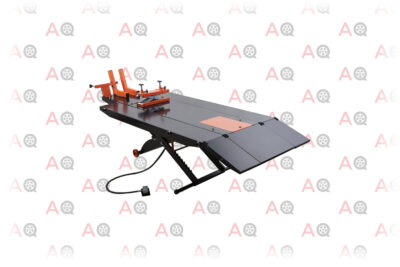
Editor’s Rating:
Quick Facts:
- Form Factor: Ramp Lift
- Lifting Mechanism: Hydraulic/Air Lift Combination
- Weight Capacity: 1,500 pounds
A consumer-friendly offering with the same features seen on auto-shop lifts, the APlusLift is a phenomenal option if you’ve got the budget. Since the lift is particularly expensive at over $1000, it’s easy to dismiss it as overpriced compared to much more economical scissor lifts. Peel away the layers a bit, though, and you can see that it’s actually a relatively economical bit of kit. Professional motorcycle lifts, such as the ones featured in mechanic shops, often run well over five grand and have mostly the same features.
While the APlusLift MT1500X isn’t designed for constant day-in, day-out use in motorcycle shops, it has an incredibly similar form factor as those professional lifts. Some of its features include adjustable table lengths for motorcycles with varying wheelbases, an eighth-inch thick steel platform for durability, a 15-inch lift for maximum accessibility, and an air-lift alongside an included (backup) scissors jack.
Since the jack does use air pressure to lift the motorcycle, you’ll need to have an air compressor on-site. The narrow platform and ramp are only compatible with two-wheeled vehicles like dirt bikes and motorcycles, so if you’re looking to work on trikes and ATVs alongside your bikes, a better pick is a combination lift like OTC’s 1545 Motorcycle/ATV lift.
Ease of Use
With absolutely minimal human input, the APlusLift is easily the easiest-to-use lift on our list. Use is remarkably simple, just roll the motorcycle onto the lift, attach it to the two anchor points on the platform, and press the button to raise using pressurized air. Height is adjustable and letting the lift down happens at a controlled pace to maximize safety. The lift doesn’t require more than one person for use.
Pros
- Cheaper than other professional-level ramp lifts
- Easy to use, automatic loading
- Loads via a ramp and lifts with compressed air
- Single-person operation
Cons
- Requires air compressor
- Expensive at over $1000
3. Best High-Capacity Motorcycle Lift: OTC 1545 Motorcycle Lift
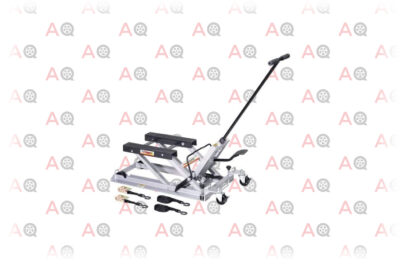
Editor’s Rating:
Quick Facts:
- Form Factor: Motorcycle/ATV Lift
- Lifting Mechanism: Hydraulic
- Weight Capacity: 1,500 pounds
The OTC 1545 combines a lot of desirable features at a $200-ish price point. Starting with a stable, ATV-capable base, this lift is much more stable and confidence-inspiring than inexpensive scissor lifts like the Orion Motor Tech Scissor Jack.
While it’s not small at about 80 pounds and with a lawnmower-sized footprint, it’s still compact enough that it won’t take up your whole garage, which can be a good thing for those with minimal space.
Lifting power comes via a hand-lever hydraulic pressure jack which is easy to operate. The long lever length and permanent handle mean that putting pressure into the hydraulic jack is quite easy. Pressure is released via a foot lever, which is a simpler mechanism than the twisting hand releases on other jacks that are susceptible to leaking hydraulic fluid. Be aware of the lowering speed, as it’s a bit tricky to control how fast the hydraulic pressure is released.
When purchasing online some assembly is required, and it takes some time to properly tighten nuts and bolts down to spec. Once assembled, though, you’ll be good to go for years with a solid base, easy lifting, and a two-year warranty. As far as combination motorcycle/ATV lifts go, this is one of the best on the market.
Ease of Use
Ease of use is fantastic as a long handle to the hydraulic pump means you don’t have to stoop even an inch to elevate the motorcycle. The one-foot lift brings the average road rider’s handlebar up to shoulder level, and the manufacturer-guaranteed o-rings make sure it stays there. Letting the motorcycle down is the most difficult part, as the lift drops the motorcycle to the ground quickly since you can’t really ‘feather’ the hydraulic pressure: it’s either on or off.
Pros
- Great ease-of-use with no small bolts and simple hydraulics
- Manufacturer-guaranteed o-rings
- One foot lift height brings motorcycle up to shoulder level
- 1,500 pound weight limit lifts even heavier motorcycles like trikes
Cons
- Lowering speed is tricky to control
4. Most Durable Motorcycle Lift: Big Red Torin Hydraulic Powersports Lift Jack

Editor’s Rating:
Quick Facts:
- Form Factor: Motorcycle/ATV lift
- Lifting Mechanism: Hydraulic
- Weight Capacity: 1,500 pounds
Chinese manufacturer Big Red brings a sturdy and inexpensive ATV/Motorcycle lift to the market called the Torin. With a 1,500 pound weight limit, a sturdy construction, and an economical price tag, it’s easy to imagine why this lift is popular with motorsport owners who own multiple types of vehicles. The lift platform is compatible with ATVs, UTVs, and motorcycles.
With solid finishes, a coat of grease-resistant paint, and a full-year warranty from the manufacturer, you’ll have at least a year of completely guaranteed hassle-free use, although based on the build quality it should last you much longer. Construction is similar to OTC’s motorcycle lift, as it uses two crossbars to support the weight of the motorcycle instead of a single platform, although the OTC has a full handle for the hydraulic jack, where this lift uses a hand lever that requires you to crouch down for operation.
Ease of Use
With four caster wheels and tight ground clearance for lower-sitting motorcycles, just park your bike and roll the lift over to the opposite side of the kickstand. As the hydraulic jack doesn’t have a large lever, it’s a bit trickier to operate than other hydraulic cylinder lifts, so you might want to have an extra hand when first hoisting and getting used to the system. Lowering the motorcycle is easy and a slow lowering speed means you have time to adjust to any imbalances. Once accustomed to the system, this is one of the easiest lifts to operate solo.
Pros
- Four caster wheels make maneuvering the jack easy
- Slim ground clearance makes the jack compatible with low-hanging motorcycles
- Solid finishes and grease-resistant paint make the jack durable
- Two crossbars are stable even when supporting heavy motorcycles
Cons
- Might need an extra hand when first learning to use the lift
5. Best Budget Motorcycle Lift: Liftmaster Wide Deck Motorcycle Lift

Editor’s Rating:
Quick Facts:
- Form Factor: Scissor Lift
- Lifting Mechanism: Hand Crank
- Weight Capacity: 1,100 pounds
Although the Liftmaster Wide Deck Lift is one of the most inexpensive scissors jacks on the market, it happens to be one of the most durable. An above-average 1100-pound weight limit holds up to the biggest of motorcycles and can even accommodate some trikes on the market. Sturdy leg supports alongside a thick crank keep things stable during operation and lifting, so there’s no leaning, shaking, or bending that sometimes happens with other lifts.
While other scissors lifts have small lifting platforms that can be unstable under heavy weights or long-wheelbase motorcycles, the Liftmaster Wide Deck has a large rubber platform that measures about 18 inches by 11 inches, contributing to the phenomenal stability of the lift.
The hand crank is simple to use but doesn’t include a socket wrench, which is necessary for operation. Although it’s a bit inconvenient that the lift can’t be operated straight out of the box we appreciate that the crank mechanism is made of a thick steel that’s nearly unbreakable.
Ease of Use
This motorcycle lift’s wide platform and solid metal construction makes it one of the easiest to use in the ‘scissor lift’ category. While it still isn’t as stable as a ramp lift like the APlusLift MT1500x, it can be operated and loaded by just one person, unlike most scissor lifts.
Pros
- One of the least expensive scissor lifts
- Can be operated by just one person
- Sturdy construction and hand crank mechanism
- Wide platform maximizes stability
Cons
- Requires a socket wrench for operation
6. Best Motocycle Scissors Jack: Extreme Max Scissors Jack

Editor’s Rating:
Quick Facts:
- Form Factor: Scissors Jack
- Lifting Mechanism: Hand Crank
- Weight Capacity: 1,000 pounds
A phenomenal scissors jack in the sub-$100 price point is the Extreme Max Scissors Jack, a larger format jack with a standard weight limit for the category and a stable, wide footprint. With a height extending up to 14 inches, the jack is designed to work best with long-wheelbase motorcycles like cruisers.
A sturdy metal construction and a hand-crank scissors mechanism lift the motorcycle into the air while a flat rubber layer on the jack platform protects the motorcycle engine and oil pan from being scraped during work.
It’s no featherweight at over 25 pounds, but it’s light and thin enough (about 3 inches when closed) to fit in a trailer or even the back seat of a car. As with all scissors jacks, part of its beauty is its simplicity: no hydraulics, no levers, no electronics. Just a simple platform that raises with the turn of a screw.
While the jack is both simple and sturdy, setup is a bit difficult in one way: it has an annoying tendency of tilting backward. It doesn’t make it unusable in any way, in fact, in some ways the backwards tilt improves access to the engine. However, it is a little bit disconcerting and we’d prefer a more stable platform.
Ease of Use
The hand crank jack only has a small seven-eighths inch nub that twists to extend upwards. Unlike the Orion Jack, which can be operated by hand, this requires a socket wrench for use. While it’s nice to have a solid handle by which to operate the jack, it’s simultaneously inconvenient to have to lug around a wrench (or worse, forget one) if you are taking this lift on the road.
Pros
- 1,000 pound weight limit
- Wide and stable footprint
- Good for motorcycles with long wheelbases like cruisers
- Simple operation without hydraulics
- Light and small enough to be transportable
Cons
- Requires socket wrench for use
- Sometimes tilts backward, especially with heavier motorcycles
7. Easiest Motorcycle Lift to Use: BikeMaster Easy Lift and Lower Off-Road Motorcycle Jack Stand
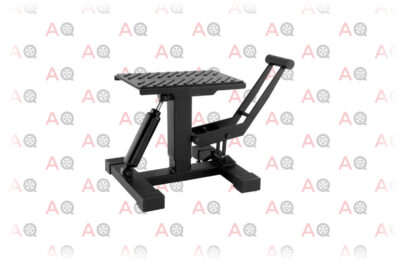
Editor’s Rating:
Quick Facts:
- Form Factor: Jack Stand
- Lifting Mechanism: Damper shock with lever
- Weight Capacity: 350 pounds
While a 350-pound weight limit doesn’t sound too different from the Extreme Max Scissors Jack’s weight limit of 300 pounds, it makes a huge difference. Those additional fifty pounds open the door to use with small, sub 250cc road bikes, and some of the most popular motorcycles on the market all fit in that 300 to 350-pound weight range.
For example, the ultra-popular Honda Rebel, Kawasaki Ninja 300, and Honda CB250 all come in that range. It’s a wonder that anyone makes a sub-300 pound jack when a slightly more capable hydraulic cylinder could open up doors for a jack to be used with a wider range of motorcycles. If you have a bike in the 300 to 350 pound weight range this jack is perfect for you. It’s simple, solid, stable, and comes in at an ultra-lean 15 pounds.
It doesn’t have the best ground clearance, and low-sitting motorcycles will have to be physically lifted onto the jack stand. Once on, though, operation is easy. The motorcycle is elevated via a simple and sturdy lever that doesn’t require delicate hydraulics. The jack stand does have a simple damping cylinder for lowering motorcycles that helps control the speed, preventing motorcycles from slamming down in the ground. For this reason, we prefer it in some ways to other jacks like the OTC 1545 that have trouble with smooth lowering.
Ease of Use
While the lever mechanism requires a bit more muscular oomph than foot-operated hydraulic jacks, it’s still easy enough for any adult or teenager to use. Our one complaint with operation is the lift platform, which forgoes a rubber pad on the sides, making it easy to scratch engine and oil cases. The lift only lifts a few inches, making it better for wheel and chain maintenance than serious, long term overhauls. For anyone looking to do minor regular upkeep, though, it’s perfect.
Pros
- Low price for motorcycle lifts
- Weight limit accommodates many popular lightweight motorcycles
- Easy operation and damping cylinder
- No delicate hydraulics
Cons
- Lever-based lift requires more muscular input than hydraulics
- Jack stand only lifts motorcycles a few inches
8. Best Portable Motorcycle Lift: Orion Motor Tech Scissor Jack
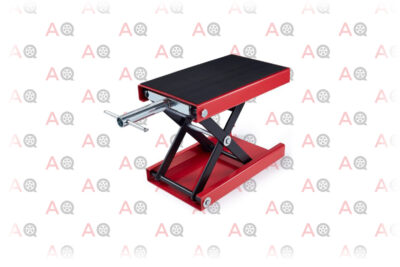
Editor’s Rating:
Quick Facts:
- Form Factor: Small-Footprint Scissor Jack
- Lifting Mechanism: Hand Crank
- Weight Capacity: 1,000 pounds
As with other scissor jacks, the Orion Motor Tech Scissor Jack uses a slowly rotating screw instead of hydraulics to lift up your motorcycle. To use it, push the motorcycle over the jack, centering it over the bottom of your motorcycle frame. After your bike is centered, attach a socket wrench to the screw mechanism to raise your machine.
Although the jack is rated to 1,000 lbs, the closer you push against the maximum weight limit, the more likely you are to strip or damage the jack. For dual-sport bikes and smaller cafe racers and cruisers, you’ll be fine for years of use, but the closer you get to the weight limit, you run a risk of damaging the jack, or worse, the bike.
A good analogy is driving a motorcycle hard—sure, you can do it, but the closer you operate to the limit of your machine, the more likely you are to have issues. The same goes with this scissor jack: mechanically, there is no issue lifting up an 800-pound motorcycle, but you’re more likely to run into problems like stripping a screw or bending a bolt.
The solid platform is collapsible, and with about the same footprint as an 8.5 by 11 sheet of paper, it’s easy enough to tuck away near your workbench or in your garage. A grease-resistant coat of paint keeps things looking sharp while a rubber base allows you to hold the bike up without the risk of scratching the frame or engine case.
Ease of Use
This portable scissor jack is not the easiest to use, and the small platform requires an additional stand to balance properly. As with all hand crank jacks, small hardware can pinch hands and be difficult to operate if not diligently greased. Since it is compatible with a socket wrench, a properly sized socket to turn the jack can go a long way.
Pros
- Very inexpensive price point
- Doesn’t require a ratchet for use
- High claimed weight limit
- Small form factor can be tucked away easily
Cons
- Small hardware is hard to use with bare hands
- Needs to be greased
9. Best Motorcycle Lift Table: Extreme Max Hydraulic Motorcycle Lift Table
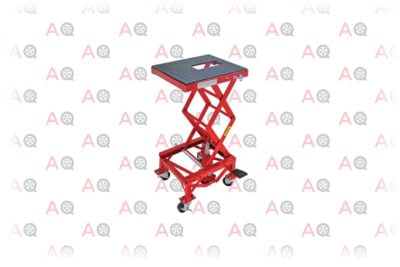
Editor’s Rating:
Quick Facts:
- Form Factor: Lift Table
- Lifting Mechanism: Hydraulic
- Weight Capacity: 300 pounds
There’s one main benefit to this lift: it gets the motorcycle high into the air at an economical price. With a useable height of 34 inches, it’s only threatened by ramp lifts like the APlusLift MT1500X in terms of lift height—but it’s $1000 cheaper. It’s stable, has a great build quality, and has a simple foot pedal operation.
However, unlike ramp lifts, this lift table only can lift a maximum of 300 lbs. While other motorcycle jacks lift a minimum of about 1000 pounds, this jack can lift only a fraction of bikes on the market.
For road bikes, there are a few bikes that come in under that 300-pound mark, but most motorcycles that weigh less than 300 pounds are small-displacement dirt bikes. If you’re mainly working on those, you’re lucky enough to get a great motorcycle lift at a fraction of the price of others. However, if you ride more typical cruisers, enduros, and dual-sports, this jack simply won’t hold up to the weight.
Ease of Use
A foot pedal means it’s second-nature to lift dirt bikes with this jack. While other jacks have small, leaky, hydraulic screws that have to be operated by hand and frequently greased, this jack demands minimal maintenance and offers simple operation.
Height is a benefit as well, as the lift takes bikes all the way up to 34 inches—this almost-three-foot extension will make even kids bikes comfortable to work on. A rubber base and caster wheels mean that you can adjust and move around the motorcycle without risk of scraping the bike.
Pros
- Foot-pedal based hydraulic cylinder makes operation easy
- Lifts motorcycles almost three feet into the air
- Rubber base and caster wheels make adjustment and movement easy
- Low price point
Cons
- A low weight limit means you can only lift lightweight motorcycles with this jack
10. Best Foot-Operated Motorcycle Lift: Pit Posse Motorcycle Hydraulic Scissor Table Stand

Editor’s Rating:
At a Glance:
- Form Factor: Hydraulic Scissors Jack
- Lifting Mechanism: Hydraulic
- Weight Capacity: 300 lbs
With a format similar to the Extreme Max Scissors Jack, this small motorcycle lift successfully combines scissors lift technology with a hydraulic cylinder, deriving performance benefits from both formats. The scissor-based expandable design keeps the jack small, able to tuck away under a workbench, while the hydraulic cylinder makes lifting easy work.
The lift, operated by a foot pedal, is simple to use. Before lifting your motorcycle, attach the jack’s sturdy stabilizing cloth straps to the important contact points of your motorcycle, creating additional stability while working on the bike. The straps are solid, and we wish we saw them on other lifts of this format.
The metal is of a thicker gauge than most scissors jacks, which makes us question why the weight limit is only 300 pounds. Perhaps it’s the design, perhaps the lift is limited by the size of the hydraulic cylinder. Either way, you’ll only be lifting mopeds and dirt bikes with this jack since other types of motorcycles are simply too heavy.
Ease of Use
Lift height is the main strong suit on this jack, and the lift operates at anywhere from 13 inches to 36 inches. This makes it particularly good for smaller dirt bikes that can be a pain to work on with smaller lifts that only prop motorcycles up by about foot. Perhaps that’s why the jack only lifts a maximum of 300 pounds, the biggest issue we have with it. That weight limit is a shame since we love this jack’s innovative format and high lift height.
Pros
- Sturdy, thick-gauge metal
- Additional straps create stability when lifting motos
- Small format can tuck away under a workbench
- Combines two types of jack designs
Cons
- Low weight limit
Guide to Buying the Best Motorcycle Lifts for 2026
If you’re a motorcyclist, chances are you spend a lot of time, money, and effort taking care of your pride and joy. A motorcycle lift can not only make maintenance much easier, but it can also make more difficult jobs possible from the comfort of your garage, teaching you about the mechanics of your bike and saving you money in the process.
How Do Motorcycle Lifts Work?
Although there are many different motorcycle jacks on the market, they typically operate in one of two ways.
Hand Crank Jacks
Hand crank jacks (the type of lifting mechanism used with scissors jacks like the ZENY 1100 Motorcycle Center Lift) use a simple screw to lift heavy objects. By turning a long screw with your hand or a wrench, the jack expands, gradually pushing the motorcycle into the sky. Since a hand crank jack is basically just a screw, it’s the cheapest type of jack to make and the simplest to maintain, just keep it well greased and periodically check for cracks, dents, or bends.
Hydraulic Jacks
Hydraulic jacks like the OTC 1545 Motorcycle Lift are typically more expensive and complicated than hand crank jacks. By compressing hydraulic fluid, either by hand or with a motor, the compressed liquid pushes against the jack platform, incrementally lifting up a heavy object, in this case a motorcycle.
Hydraulic jacks are easy to use and don’t require much strength but fragile o-rings and leaky hydraulic fluid can be inconvenient and messy. For a long lifespan, keep your jack clean, lubricate screws and hardware, and make sure that your hydraulic cylinder isn’t leaking.
Other Types of Motorcycle Stands
Though the above products are the best ways to safely get your bike off the ground, there are a few other ways you can get the job done.
Lift/Wheel Stands
Depending on the design, a lift may raise your motorcycle off the ground but not stabilize it there. Larger footprint ramp jacks are fixed and therefore secure, but smaller jacks like scissor lifts need an additional piece of equipment called a wheel stand or lift stand to help prevent the bike from falling over. You can also potentially use a sturdy piece of material to help balance your bike.
Center Stand
If you ride a motorcycle with a center stand, it’s not urgent to have a motorcycle lift. A center stand can give you good access, raising the wheels off the ground even to do more complex operations. If you have some wood or even a milk crate, you can balance your motorcycle and do drivetrain work with just a center stand. The heavier your motorcycle, the more difficult and dangerous this balance point becomes, and if you’ve got a bike over 500cc, it’s probably prudent to drop a few dollars on having the right tools for a job.
Dirt Bike Stands
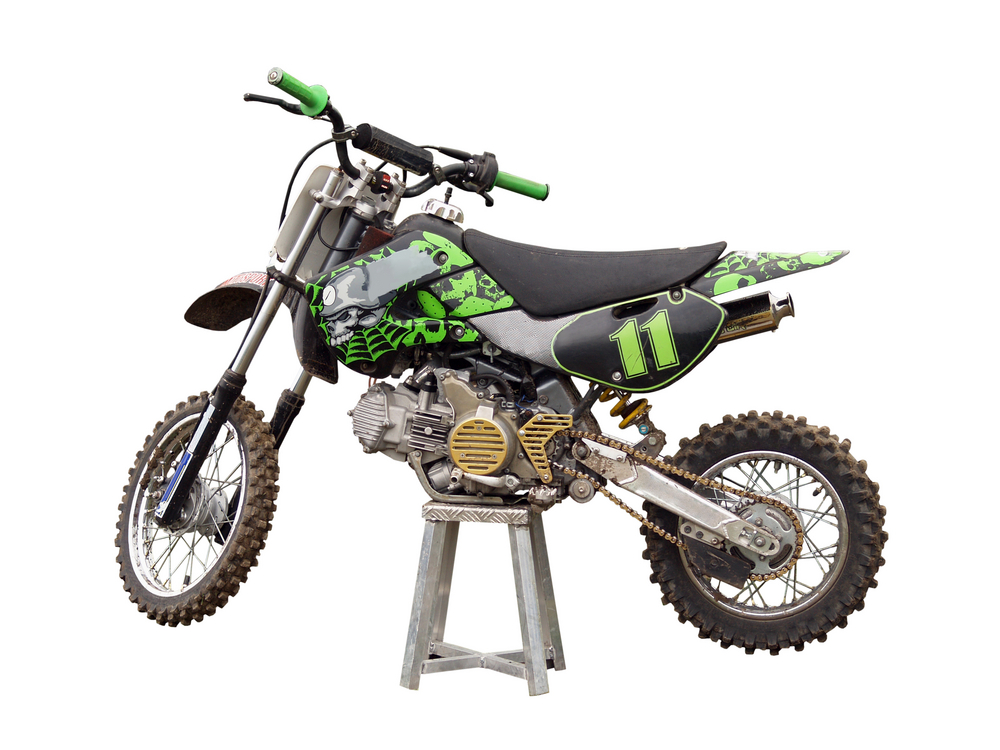
If you have a dirt bike or dual sport bike, a great addition to a motorcycle lift is a dirt bike stand. These stands go under the center of the bike, where a typical center stand is located, and enable the wheels and drivetrain to work independently off the ground. A dirt bike stand is a convenient and most importantly a mobile way to lift the bike up high enough to do work that requires wheels to be off the ground.
If you work on your motorcycle at the track or if you tow your motorcycle with you at all, a full motorcycle lift is, in the majority of cases, pretty impractical. But if you want a way to elevate your dirt bike in a simple way that you can throw in a trailer or even the back seat of your car, a dirt bike stand is the way to go.
One thing to note: since there’s no jack involved, you have to push the motorcycle onto the stand yourself, so those that can’t lift a bike should check out an option like the Extreme Max Lift Table.
Resources for Wrenching
Once you own your own motorcycle lift, you’ll probably want to break it in with some projects, upgrades, or overhauls. If you haven’t ever poked around on the internet looking for motorcycle mechanic resources, take this time to familiarize yourself—there are some incredibly talented mechanics sharing their knowledge on the internet for free.
- FortNine: A YouTube collective based out of Canada, some of the most interesting and useful motorcycle information out there comes from the hyper-knowledgeable and clever Ryan F9, a lifelong motorcycle lover and guru. With everything from mods to mechanical jobs and motorcycle reviews, the team provides a ton of value with expertly filmed 10-minute videos that are hard to get enough of.
- com: Typically focusing on industry news, tips, and mechanical help, TheRideAdvice.com is a great mechanical resource with clear visual guides for most simple motorcycle jobs.
- MC Garage: In recent years, formerly print-only Motorcyclist magazine launched an impeccable YouTube channel that goes into remarkable detail on even complex jobs like slipper clutch rebuilds and brake caliper services.
These three online outlets are great places to start for motorcycle inspiration, but there are hundreds of mechanics out there with plenty of free info online. The answers to your most difficult motorcycle maintenance questions are typically just a google search away.
Projects Fit for a Motorcycle Lift
Once you have a motorcycle lift, the door is open to a whole host of jobs that were otherwise difficult. It will also make working on cosmetic features on your bike much less complex. A few ideas of jobs that a lift will make easier are:
- Oil Change: Switching oil is a routine job that is easy to complain about. It’s simple enough, but every 2000 miles can feel quite frequent if you’re riding a lot. It’s also a dirty job without a lift, as you have to lie on the ground to access the oil pan. With a lift, the motorcycle comes to you, and the oil change will go twice as smoothly, and twice as fast.
- Cosmetic Modifications: Let’s face it, wrenching on a bike that’s resting on its kickstand is not only inconvenient, but it can also be dangerous. You’re working at an angle, leaning over your bike on an unstable point of contact. A motorcycle lift brings things up to body level, meaning you no longer have to stoop over when installing seats, handlebars, or anything else on top of the bike.
- Brake and Wheel Work: Brake and wheel work is a motorcycle lift’s bread and butter: if a wheel can’t spin freely, you simply can’t work on it. Hydraulic hoses are more exposed, wheels can be balanced, and brakes become accessible.
- Wheel Alignment and Balancing: Many bikers shy away from balancing and aligning wheels due to the intricate nature of the job. With a free-spinning wheel, though, things become a lot easier. A motorcycle lift gives you a good view and without too much trouble, you can end up with a wheel that’s perfectly spinning, aligned, and balanced.
With a motorcycle lift, you’ll be able to do many jobs that you thought about paying for previously. Use this new tool to get a handle on some bigger tasks and get to know your motorcycle. For some more complex tasks that most riders should know (but probably don’t) check out this video below.
Safety
Whenever lifting up a heavy object like a motorcycle, a lot of thought needs to go into planning how the bike will be loaded and balanced. Over 500 pounds of metal is not pretty when it crashes to the ground, and it’s particularly ugly when someone happens to be actively wrenching. Inventors are working tirelessly to make motorcycle lifts safer, filing patents on motorcycle lifts to keep mechanics safe from harm. However, to ensure your personal safety, there are still several factors to consider when working on and lifting heavy bikes.
- Alerting a Friend: One of the most common sources of injury with a motorcycle lift is a motorcycle falling on its owner, trapping them. Make sure to alert someone nearby that you’re working on your motorcycle in case it falls off balance.
- Using a Lift/Wheel Stand: While it is possible to balance a motorcycle without a wheel stand, it’s not a great idea. If you’re lifting your motorcycle, use the jack to elevate it and then place the lift or wheel stand under the wheel immediately afterwards to help ensure the balance of your bike. At worst it’s a mild inconvenience, at best it will save your motorcycle (or your life).
- Asking for Help: Motorcycles are big pieces of equipment, and if you’ve got a bike bigger than 1000cc, you know first hand how heavy and hard-to-maneuver it can be. Use your common sense, know your limits, and when loading or unloading a bike from a motorcycle lift, don’t be afraid to ask for an extra pair of hands.
Weight Limits
Manufacturer-reported weight limits can be a bit confusing when you’re shopping for, or even using, a motorcycle lift. There’s a tremendous incentive for these manufacturers to slap on the highest number possible, as at the same price point for a similar product, customers will purchase the product with a higher weight limit.
While there’s nothing wrong with a high weight limit, it doesn’t actually mean that you’re purchasing a better jack. Lifts are typically tested to 105% of their weight limit, which leaves little room for error. Over time, hydraulic seals and cylinders wear out, making them less able to hold the full reported weight.
Motorcycle lifts typically don’t fail catastrophically, which is a relief—most commonly a seal will break, slowly leaking hydraulic fluid and letting down the motorcycle slowly. Still, it’s not a pleasant experience.
So what does this mean for users? Weight limits are not that meaningful unless you look at other factors. How old is the jack? How close are you to the weight limit? A good rule of thumb is to stay around 75% of the maximum weight limit, especially with older jacks. Replace your lift every five years, or if you have an expensive lift or jack, get it serviced at the recommended intervals. These tips will help you have safe and failure-free maintenance every time. Take care of your tools like you would take care of your motorcycle.
Frequently Asked Motorcycle Lift Questions
Do I Need a Motorcycle Lift?
Motorcycle lifts can take up a lot of space, be difficult to use, and be expensive. So why would anyone want one? The answer, as with a lot of motorcycle questions, is not as simple as it seems. Motorcycle people are a different breed. Motorcycles are a unique type of machine, and they require unique tools for wrenching.
Even though motorcycle lifts can take up space, be difficult to use, and be expensive, on some level, there isn’t much of an alternative if you want to be serious with your motorcycle maintenance. If you’re going to do a job more involved than an oil change, you’ll need to figure out a way to lift up your motorcycle. Frequently, the best way to do this is with a motorcycle lift.
What Is a Motorcycle Lift For?
Just like a car jack, a motorcycle lift is meant to make mechanical work easier. Motorcycle jacks typically lift the whole bike off the ground, while car jacks meant for consumers typically only lift a corner of the vehicle.
A motorcycle jack consists of at least two parts: a platform on which to lift the motorcycle and a lifting mechanism, like a hand-crank or hydraulic cylinder to lift the motorcycle. Once the motorcycle is elevated, it’s important that the motorcycle stays steady and balanced so that work is easy and safe. For this reason, stability is a huge priority when manufacturing jacks.
Can I Just Use a Car Jack?
Both motorcycle lifts and car jacks lift heavy weights, use similar technology, and most motorcyclists already have a car jack— so it’s a reasonable question to ask if you can use a car jack as a motorcycle lift. Unfortunately, most of the time, it’s simply not safe to use a car jack instead of a motorcycle lift.
Motorcycle jacks and lifts exist for a reason, and car jacks exist for separate and distinct reasons. Motorcycle lifts are designed to pick up an entire bike, and with the aid of a lift stand or sturdy object under the front wheel, the bike can balance by itself. Car jacks, typically bottle jacks, are not designed to balance anything, simply lift the corner of the car. Some expensive and full-garage car lifts could work to lift a motorcycle, but the simple bottle jack or scissor jack you have with your spare tire unfortunately won’t work.
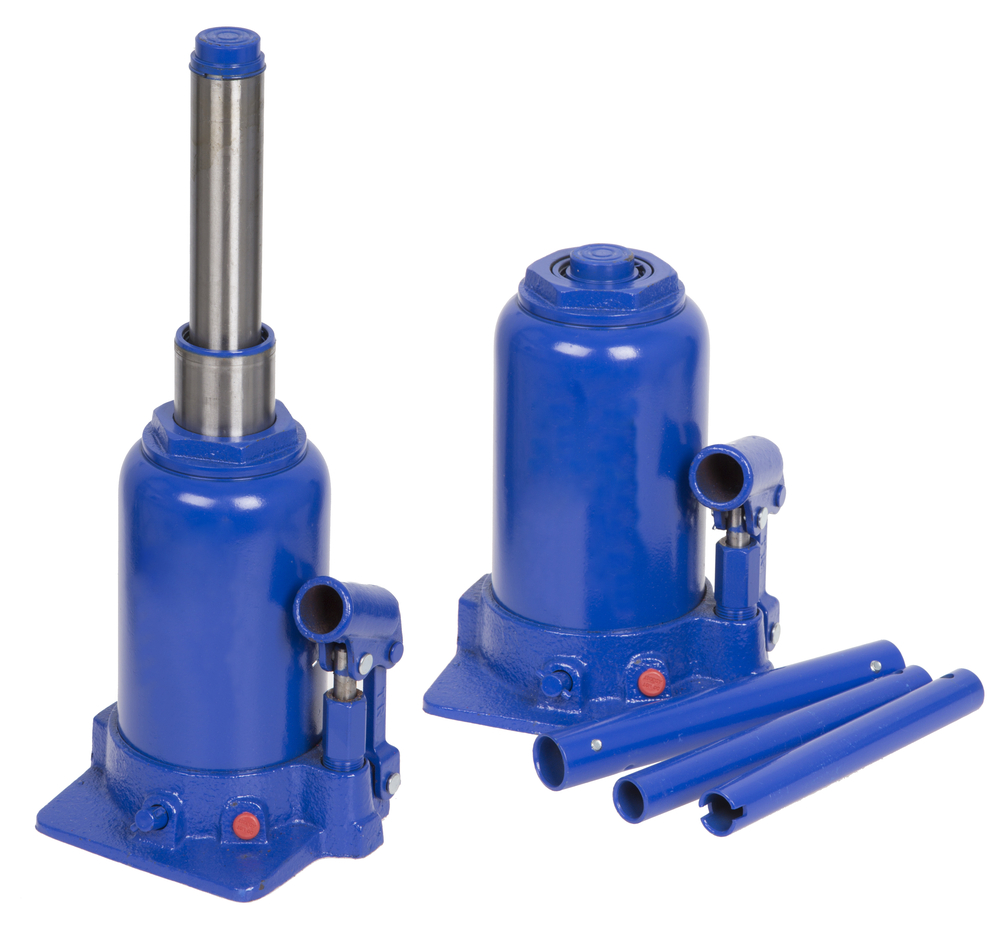
Wrapping Up
While simple scissors jacks can be had for well under $100, it’s important to consider exactly what you need in a jack. If you’re a weekend warrior just looking to change your own oil, you’ll be fine with something simple. If you’re buying something to work on multiple bikes and create the workshop of your dreams, a platform lift like the PlusLift MT1500X can more than justify the expensive price tag.
When getting into at-home wrenching, a motorcycle lift can make mechanical work much easier. Improving accessibility to the engine, clutch, and drivetrain, stabilizing the bike, and orienting the motorcycle an upright position, a lift makes the inconvenient jobs convenient and the hard jobs possible.
